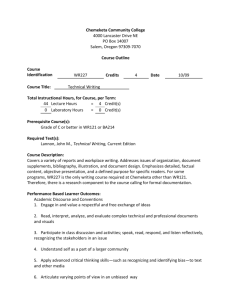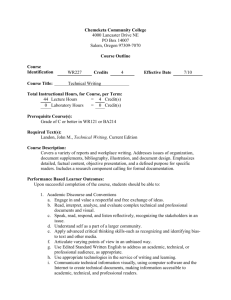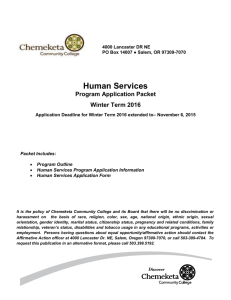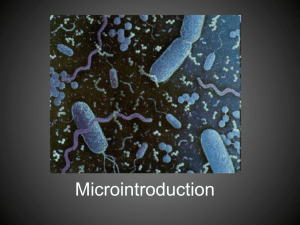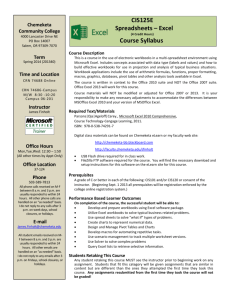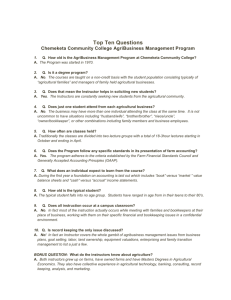+ H - faculty at Chemeketa - Chemeketa Community College
advertisement
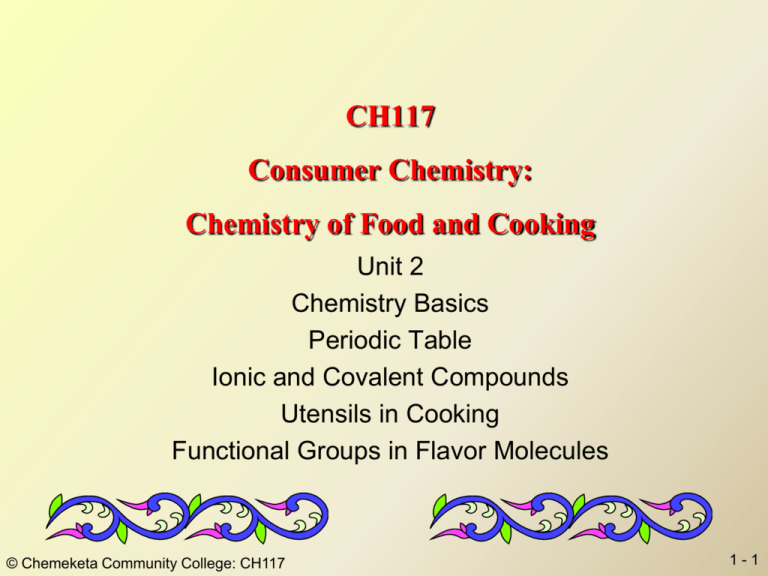
CH117 Consumer Chemistry: Chemistry of Food and Cooking Unit 2 Chemistry Basics Periodic Table Ionic and Covalent Compounds Utensils in Cooking Functional Groups in Flavor Molecules © Chemeketa Community College: CH117 1-1 What is Chemistry? “The study of Matter and its Changes.” Matter The stuff things are made of. Has Mass and Volume (takes up space). (Air, water, rocks, etc..) Mass = The amount of stuff (in g’s) (Bowling Ball > Balloon) Weight = Pull of Gravity on matter. © Chemeketa Community College: CH117 1-2 A model of matter Pure Substance - something of uniform composition that can’t be sorted further by differences. • Element - Pure substance composed of only one kind of atom. • ie. Table of known elements Chemical Compound - A pure substance that is a combination of different elements. ie. Water (H2O) ie. Carbon Dioxide (CO2) ie. Salt (NaCl) © Chemeketa Community College: CH117 1-3 A model of matter Mixture- NOT of uniform composition and CAN be sorted further by differences. • Homogeneous – Looks pure but is not. ie. Salt or Sugar Water (H2O + NaCl) ie. Homogenized Milk •Heterogeneous - Visibly a combination of different substances. ie. Pizza ie. Chocolate Chip Cookies ie. Granite © Chemeketa Community College: CH117 1-4 A model of matter Atom - The smallest unit of an element that is still that element. ie. Aluminum (Al) Molecule -The smallest unit of bonded atoms that is still that substance. Contains > 1 atom or element. ie. Water (H2O) ie. Carbon Dioxide (CO2) ie. Oxygen (O2) ie. Not Salt (NaCl) © Chemeketa Community College: CH117 1-5 Classification of matter Matter Pure Substance Element Fe Mg Compound FeS MgO © Chemeketa Community College: CH117 Mixture Heterogeneous Homogeneous Fe + S Mg + O2 1-6 Mixtures Mixture Homogeneous (Solution) Uniform composition Heterogeneous Non-uniform composition Air Pizza Tea w/ice Gasoline Urine Milk © Chemeketa Community College: CH117 Sand 1-7 Hydrogen Elements & Symbols Sodium (Natrium) Potassium (Kalium) Carbon Aluminum Calcium Nitrogen Iron Chlorine Copper (Cu) (Ferrum) Gold (Aurum) Each element is assigned a unique symbol 1-2 letters; 1st is capitalized The original name is often of Latin or Greek origin © Chemeketa Community College: CH117 1-8 Modern periodic table IA 1 2 Mendeleev, 1871 III A IV A V A VI A VIIA VIIIA “Properties of the elements He vary in a periodic manner.” II A H Li Be Na Mg III B IVB V B VIB VIIB 3 4 5 6 7 K Ca Sc Ti Rb Sr Y V IB IIB C N O F Al Si P S Cl Ar Ne CrThe Mn periodic Fe Co Nitable Cu Zn Ga Ge As Se Br Kr helps us understand •behavior, W Re •reactions Os Ir Pt Au Hg Tl Pb •properties CeofPrthe Nd elements. Pm Sm Eu Gd Tb Dy Ho Zr Nb Mo Tc Ru Rh Pd Ag Cd In Sn Sb Te Cs Ba Ls Hf Ta Fr Ra Ac VIII B B I Xe Bi Po At Rn Er Tm Yb Lu Th Pa U Np Pu Am Cm Bk Cf Es Fm Md No Lr © Chemeketa Community College: CH117 1-9 A row or period Periods are assigned numbers 1 H 2 Li Be B C N O F 3 Na Mg Al Si P S Cl Ar 4 K 5 Rb Sr 6 Cs Ba Ls Hf Ta W Re Os Ir 7 Fr Ra Ac Ca Sc Ti Y V He Ne Cr Mn Fe Co Ni Cu Zn Ga Ge As Se Br Kr Zr Nb Mo Tc Ru Rh Pd Ag Cd In Sn Sb Te I Xe Pt Au Hg Tl Pb Bi Po At Rn Ce Pr Nd Pm Sm Eu Gd Tb Dy Ho Er Tm Yb Lu Th Pa U Np Pu Am Cm Bk Cf Es Fm Md No Lr © Chemeketa Community College: CH117 1 - 10 Common group names Alkali Metals Alkaline Earth Metals IA H Noble gases II A Li Be Ca Sc Ti VIIIA III A IV A V A VI A VIIA Transition Metals Na Mg III B IVB V B VIB VIIB K Halogens V VIII B IB IIB He B C N O F Ne Al Si P S Cl Ar Cr Mn Fe Co Ni Cu Zn Ga Ge As Se Br Kr Lanthanides Rb Sr Y Zr Nb Mo Tc Ru Rh Pd Ag Cd In Sn Sb Te Cs Ba La Hf Ta W Re Os Ir I Pt Au Hg Tl Pb Bi Po At Rn Fr Ra Ac Ce Pr Nd Pm Sm Eu Gd Tb Dy Ho Er Tm Yb Lu Actinides Th Pa U Np Pu AmCm Bk Cf Es Fm Md No Lr © Chemeketa Community College: CH117 Xe 1 - 11 Why do we have those rows on the bottom? H He This arrangement takes too B C Na Mg much space and is hard to read.Al Si Li Be N O F Ne P S Cl Ar K Ca Sc Ti V Cr Mn Fe Co Ni Cu Zn Ga Ge As Se Br Kr Rb Sr Y Zr Nb Mo Tc Ru Rh Pd Ag Cd In Sn Sb Te I Xe Cs Ba Ls Ce Pr NdPmSmEu Gd Tb Dy Ho Er TmYb Lu Hf Ta W Re Os Ir Pt Au Hg Tl Pb Bi Po At Rn Fr Ra Ac Th Pa U Np PuAmCmBk Cf Es FmMdNo Lr © Chemeketa Community College: CH117 1 - 12 Names & Symbols Know the names & symbols 1 H 2 Li Be B C N O F 3 Na Mg Al Si P S Cl Ar 4 K 5 Rb Sr 6 Cs Ba Ls Hf Ta W Re Os Ir 7 Fr Ra Ac He Ca Sc Ti Y V Ne Cr Mn Fe Co Ni Cu Zn Ga Ge As Se Br Kr Zr Nb Mo Tc Ru Rh Pd Ag Cd In Sn Sb Te I Xe Pt Au Hg Tl Pb Bi Po At Rn Ce Pr Nd Pm Sm Eu Gd Tb Dy Ho Er Tm Yb Lu Th Pa U Np Pu Am Cm Bk Cf Es Fm Md No Lr © Chemeketa Community College: CH117 1 - 13 Lustrous, malleable and ductile. Metals Solids at room temp (except Hg) H Conductors (heat & electricity); electrons loose so can move freely (flow) and spread energy so He make good cooking pans (ie. Al, Fe, Cu) Li Be Give electrons to nonmetalsB (Form (+) ions C N O F). Ne Na Mg K Al Ca Sc Ti Rb Sr Y V P S Cl Ar Cr Mn Fe Co Ni Cu Zn Ga Ge As Se Br Kr Zr Nb Mo Tc Ru Rh Pd Ag Cd In Sn Sb Te Cs Ba Ls Hf Ta W Re Os Ir Fr Ra Ac Si I Xe Pt Au Hg Tl Pb Bi Po At Rn Ce Pr Nd Pm Sm Eu Gd Tb Dy Ho Er Tm Yb Lu Th Pa U Np Pu Am Cm Bk Cf Es Fm Md No Lr © Chemeketa Community College: CH117 1 - 14 Remember Specific Heat 30o 20o Low SpHt; Heats quickly Stainless steel (Fe/Cr/Ni all ~0.1) heats fast. Cu on bottom heats faster. 10o 1o Al 0.22 H2O 1.00 Sand 0.19 Fe 0.11 Cu 0.093 Au 0.031 Ag 0.057 High SpHt; Resists change Cast Iron skillets (Fe/C) have more mass compared to normal Al or Stainless steel pans which is why they heat & cool slowly and hold heat longer than an Al or Fe pan of lower mass. © Chemeketa Community College: CH117 1 - 15 Non-metals H Li Be He B C N O F Na Mg Al Si Gas, liquid, solid (dull, brittle); Many are diatomic P S Cl Ar K Ca Sc Ti V Cr Mn Fe Co Ni Cu Zn Ga Poor conductors (Insulators); electrons held rigid in covalent bonds so can’t flow. Rb Sr SiO Y Zr Nb Mo Tc Ru Rh Pd Ag Cd In Glass, 2, heats slower than metal; Baking (hot air) is slower than Frying or Cs Ba Ls Hf Ta W Re Os Ir Pt Au Hg Tl boiling. Convection ovens make faster. Ge As Se Br Kr Sn Sb Te © Chemeketa Community College: CH117 I Xe Pb Bi Po At Rn Fr Ra Ac Take electrons from (Form ions); Ce metals Pr Nd Pm Sm Eu(-)Gd Tb Dy Ho Th Pa Uwith Np Pu Am Cm Bk Cf Share electrons (covalent) other nonmetals Ne Er Tm Yb Lu Es Fm Md No Lr 1 - 16 Metaloids H He Li Be B C N O F Na Mg Al Si P S Cl Ar K Ca Sc Ti Rb Sr Y V Ne Cr Mn Fe Co Ni Cu Zn Ga Ge As Se Br Kr Zr Nb Mo Tc Ru Rh Pd Ag Cd In Sn Sb Te Intermediate properties Cs Ba Ls Hf Ta W Re Os Ir I Xe Pt Au Hg Tl Pb Bi Po At Rn Semi conductors Fr Ra Ac Ce Pr Nd Pm Sm Eu Gd Tb Dy Ho Er Tm Yb Lu Th Pa U Np Pu Am Cm Bk Cf Es Fm Md No Lr © Chemeketa Community College: CH117 1 - 17 3 - 11 Metals Non-metals Metaloids H He Li Be B C N O F Na Mg Al Si P S Cl Ar K Ca Sc Ti Rb Sr Y V Cr Mn Fe Co Ni Cu Zn Ga Ge As Se Br Kr Zr Nb Mo Tc Ru Rh Pd Ag Cd In Sn Sb Te Cs Ba Ls Hf Ta W Re Os Ir Fr Ra Ac Ne I Xe Pt Au Hg Tl Pb Bi Po At Rn Ce Pr Nd Pm Sm Eu Gd Tb Dy Ho Er Tm Yb Lu Th Pa U Np Pu Am Cm Bk Cf Es Fm Md No Lr © Chemeketa Community College: CH117 1 - 18 A model of matter Atom - The smallest unit of an element that is still that element. ie. Aluminum (Al) Molecule -The smallest unit of a pure substance that is still that substance. May contain > 1 atom or element. ie. Water (H2O) © Chemeketa Community College: CH117 1 - 19 Structure of the atom Nucleus Small, dense, + charge in the center of an atom. contains protons & + + + + + + neutrons © Chemeketa Community College: CH117 1 - 20 Structure of the atom Nucleus (+) Electrons - charged particles that surround the nucleus. Electrons move around nucleus in orbitals. © Chemeketa Community College: CH117 1 - 21 Structure of the atom The nucleus is a small part of an atom. If the nucleus was the size of a marble, the atom would fill a football stadium. The nucleus would weigh over 10,000 tons. Atoms are mostly empty space. Atoms have a small, dense nucleus with + charge. © Chemeketa Community College: CH117 1 - 22 The atomic symbol C = Charge A = Atomic mass = + or - values A Z X Z = Atomic number = # protons = # electrons © Chemeketa Community College: CH117 C # # = Number of atoms in a formula. 1 - 23 The atomic symbol C = Charge A = Atomic mass = + or - values 16 8 O Z = Atomic number = # protons = # electrons © Chemeketa Community College: CH117 2- # = Number of atoms in a formula. 1 - 24 Electron arrangement 24 Mg 12 32 18 2 Electrons fill layers around nucleus Low High 8 A new layer is added for each row or period in the table. Shells = Energy levels © Chemeketa Community College: CH117 1 - 25 1 H 1 IA 7 Li 3 II A 4 He 2 9 Be 4 2, 1 © Chemeketa Community College: CH117 2, 2 1 - 26 1 H 1 IA 7 Li 3 II A 9 Be 4 2, 1 © Chemeketa Community College: CH117 2, 2 IIIA 11 B 5 2, 3 1 - 27 IIIA 11 B 5 IVA 13 N 7 12 C 6 2, 3 © Chemeketa Community College: CH117 VA 2, 4 2, 5 1 - 28 IA IIA 1 1H 7 Li 3 4 He 2 9 4Be 2, 2 2, 1 23 Na 11 VIIIA 24 12Mg 2, 8, 1 © Chemeketa Community College: CH117 2, 8, 2 20 Ne 10 2, 8 40 18Ar 2, 8, 8 1 - 29 1 1 1 Octet Rule H 2 9 4 Be 7 3 Li 2, 1 23 Na 11 8 4 2 He 20 Ne 10 2, 2 24 12 2, 8, 1 © Chemeketa Community College: CH117 Mg 2, 8, 2 2, 8 40 18 Ar 2, 8, 8 1 - 30 1 1 1 Valence electrons Where most chemical Reactions occur. H 2 9 4 Be 7 3 Li 2, 1 23 Na 11 3 11 5 B 2, 3 2, 2 24 12 2, 8, 1 © Chemeketa Community College: CH117 Mg 2, 8, 2 27 13 Al 2, 8, 3 1 - 31 1 1H Electron Dot Structures H 7 Li 3 Li 23 11 Na Show only Valence Electrons Na K © Chemeketa Community College: CH117 1 - 32 1 H 8 He 2 3 4 5 6 7 Li Be B C N O F Ne Na Mg Al Si P S Cl As Se Br Kr K Ca Ga Ge © Chemeketa Community College: CH117 Ar 1 - 33 Electron Affinity Relative ability of atoms to attract electrons Oxidation: When electrons are grabbed by a “hungry” element like Oxygen (O) or Chlorine (Cl) H Li Be B C N O F Na Mg Al Si P S Cl K Ca Ga Ge As Se Br Rb Sr In Sn Sb Te I Cs Ba Tl Pb Bi Po At © Chemeketa Community College: CH117 1 - 34 4 - 50 23 11 Na Ions 11 +’s 11 -’s 0 Na Metals give e-s to make (+) ions (Cations) 11 +’s 10 -’s 1+ Na1+ 2, 8 = [Ne] Now has e-s like Ne © Chemeketa Community College: CH117 1 - 35 35 Cl 17 Ions 17 +’s 17 -’s Cl 0 Nonmetals take e-s to make (–) ions (anions) 17 +’s 18 -’s 2, 8, 8 = [Ar] © Chemeketa Community College: CH117 1- Cl = Cl1- 11 - 36 Formation of NaCl e- moves from Metal Nonmetal Stable octets Na + Cl + Na Metal Cation _ + Cl Nonmetal Anion + and - ions attract to form an ionic bond. Chemical Equation = expression of a reaction Na + Cl NaCl © Chemeketa Community College: CH117 1 - 37 Properties of Ionic compounds • • • • Not individual molecules Form crystal arrays Ions touch many others Formula represents the average ion ratio Na Cl Cl Na Cl Na © Chemeketa Community College: CH117 NaCl sodium chloride 1 - 38 Common ions Representative Elements 1+ 4+ H 2+ Li Be 3+ 4- 3- 2- 1- He Transition Elements Variable Na Mg K Ca Sc Ti Rb Sr Y V C N O Al Si P S F Ne Cl Ar Cr Mn Fe Co Ni Cu Zn Ga Ge As Se Br Kr Zr Nb Mo Tc Ru Rh Pd Ag Cd In Sn Sb Te Cs Ba Ls Hf Ta W Re Os Ir Fr Ra Ac B I Xe Pt Au Hg Tl Pb Bi Po At Rn Ce Pr Nd Pm Sm Eu Gd Tb Dy Ho Er Tm Yb Lu Th Pa U Np Pu Am Cm Bk Cf Es Fm Md No Lr © Chemeketa Community College: CH117 1 - 39 Ionic Formulas Metal Cations + Nonmetal Anions Na1+ Cl1- NaCl Sodium Chloride Mg2+ Cl1Cl1- MgCl2 Magnesium Chloride Table Salt Used for taste & preserving Mined from earth & from Sea © Chemeketa Community College: CH117 In Sea Salt; tastes bitter 1 - 40 Polyatomic Ions Ca2+ CO32- CaCO3 Calcium Carbonate Sea shells, egg shells, Limestone, Marble; Mg2+ SO42- MgSO4 Magnesium Sulphate In Sea Salt Used to remove Ca from sea salt © Chemeketa Community College: CH117 1 - 41 Naming Practice Common ingredients KI CuO TiO2 SiO2 KNO3 Fe2SO4 Potassium Iodide (to iodize salt) Copper (II) Oxide or Cupric Oxide Titanium oxide (white paint pigment) Silicon Dioxide (anti-caking agent) Potassium Nitrate (in fertilizer) Ferric Sulfate (Iron in vitamins) Sodium bicarbonate NaHCO3 Ca3(PO4)2 Calcium Phosphate (in milk) (baking soda) © Chemeketa Community College: CH117 1 - 42 Nonmetals Share e-s 1 H with other nonmetals 2 3 4 5 Be B C N O Na Mg Al Si P Li 6 S 7 8 He F Ne Cl Ar Metals give e-s to nonmetals K Ca Ga Ge As Se Br Kr © Chemeketa Community College: CH117 1 - 43 Properties of covalent compounds Covalent compounds •Discrete molecular units O=O •Atoms held together by bonds •Covalent compounds exist in all states (CO2 - gas, H2O - liquid, SiO2 - solid) •Formula represents atoms in a molecule © Chemeketa Community College: CH117 1 - 44 Covalent Bonds H + H H H Cl + Cl Cl Cl O + O O O N + N N © Chemeketa Community College: CH117 N 1 - 45 Covalent Bonds H H H-H H2 Cl Cl Cl-Cl Cl2 O O O=O O2 N N © Chemeketa Community College: CH117 N N N2 1 - 46 Covalent Bonds Carbon monoxide C O CO C O CO2 O=C=O Carbon dioxide O C O May modify rules to improve sound. ie - monoxide not monooxide. © Chemeketa Community College: CH117 1 - 47 Common Covalent compounds CO CO2 SiO2 CH4 carbon monoxide carbon dioxide silicon dioxide (in sand, glass) CH3CH2CH3 CH3CH2OH CH3CO2H © Chemeketa Community College: CH117 Methane (Natural gas) Propane (cooking gas) Ethanol (drinking alcohol) Acetic Acid (vinegar) 1 - 48 Tetrahedral electron-pair Geometries Tetrahedral Pyramidal © Chemeketa Community College: CH117 Bent 1 - 49 Bond Polarity, Electron pull This unequal sharing results in polar bonds. H Cl Electrons in covalent bonds rarely get shared equally. H + •Slight positive side •Smaller electron pull © Chemeketa Community College: CH117 Cl - •Slight negative •Larger electron pull 1 - 50 Electronegativity Relative ability of atoms to attract electrons when they form bonds. H 2.20 Li Be B Na Mg Al C 2.55 Si N 3.04 P 2.19 O F 3.44 3.98 S Cl 2.58 3.16 K Ca Ga Ge As Se Rb Sr In Sn Sb Te I Cs Ba Tl Pb Bi Po At © Chemeketa Community College: CH117 Br 2.96 1 - 51 Ionic vs Covalent Ionic Polar Covalent Nonpolar covalent Like NaCl Like sugar, water, ethanol, Vit C Like oil, gasoline, hexane, Vit C Strong attractions: Moderate attractions: Ionic Polar; H-bonds High mp (1474F,801C) Low mp H2O (0C), High bp Low bp H2O 100C; (2575F, 1413C) EtOH 78C © Chemeketa Community College: CH117 Weak attractions: Vander Waals Lowest mp/bp 1 - 52 Attractive Forces Ionic Bonds 150 - 3000 kcal mol Melting Point © Chemeketa Community College: CH117 NaCl 801oC Na2S 920oC MgF2 1248oC 1 - 53 Attractive Forces Dipole-Dipole 0.1 - 1 kcal mol H Melting Point + Cl - + H + H Cl - © Chemeketa Community College: CH117 - HCl Cl CH3F + H Cl -114oC -142oC - 1 - 54 Attractive Forces Van der Waals 0.01 kcal mol (Dispersion Forces) + Cl Cl - Melting Point + + Cl Cl - Cl Cl - + © Chemeketa Community College: CH117 Cl Cl2 -102oC CH4 -183oC Cl - 1 - 55 Attractive Forces Hydrogen Bonds - O + H H + O + H H + Polar Attraction © Chemeketa Community College: CH117 1 - 56 Hydrogen Bonding of Water 5 - 10 kcal mol Hydrogen Bonds Melting Point H 2O 0oC NH3 -78oC Boiling Point © Chemeketa Community College: CH117 H 2O 100oC NH3 -33oC 1 - 57 Ionic vs Covalent Ionic Polar Covalent Nonpolar covalent Like NaCl Like sugar, water, ethanol, Vit C Like oil, gasoline, hexane, Vit C Strong attractions: Moderate attractions: Ionic Polar; H-bonds Weak attractions: Vander Waals High mp (1474F,801C) Low mp H2O (0C), High bp Low bp H2O 100C; (2575F, 1413C) EtOH 78C Lowest mp/bp Many water soluble Soluble in water Insoluble in water Form ions in water (electrolytes) Don’t ionize in water © Chemeketa Community College: CH117 1 - 58 Dissoving of Ionic Compounds Polar water attracts to Na+ and Cl- ions “Like Dissolves Like” When an ionic solid dissolves in water, the polar solvent removes ions from the crystal lattice. © Chemeketa Community College: CH117 1 - 59 Dissoving of Ionic Compounds “Like Dissolves Like” © Chemeketa Community College: CH117 1 - 60 Dissolving covalent compounds Covalent compounds do not break into ions. © Chemeketa Community College: CH117 1 - 61 Electrolytes Ionic (Salt) (sugar) C6H12O6 NaCl Cl- Covalent Na+ Na+ Cl Dissolved Ions in solution NaCl Na+ + Cl© Chemeketa Community College: CH117 C6H12O6 C6H12O6 No Ions in solution 1 - 62 Ionic vs Covalent Ionic Polar Covalent Nonpolar covalent Like NaCl Like sugar, water, ethanol, Vit C Like oil, gasoline, hexane, Vit C Strong attractions: Moderate attractions: Ionic Polar; H-bonds Weak attractions: Vander Waals High mp (1474F,801C) Low mp H2O (0C), High bp Low bp H2O 100C; (2575F, 1413C) EtOH 78C Lowest mp/bp Many water soluble Soluble in water Insoluble in water Form ions in water (electrolytes) Don’t ionize in water Not flammable Flammable © Chemeketa Community College: CH117 Flammable 1 - 63 Organic Functional Groups Hydrocarbons © Chemeketa Community College: CH117 1 - 64 Drawing Covalent Compounds Practice building: Build with models Hexane Ethylene Ethanol (an alcohol) Isopropyl alcohol Cinnamaldehyde (an aldehyde) Acetone (a ketone) Acetic Acid (a carboxylic acid) Butyric Acid Phenol © Chemeketa Community College: CH117 1 - 65 Flavors: Terpenes CH3 Limonene Citronellol Orange/lemons Roses/geraniums OH © Chemeketa Community College: CH117 1 - 66 Smell: R-(-)-carvone Spearmint © Chemeketa Community College: CH117 S-(+)-carvone Caraway (Dill) (Manderine Orange Peel) 67 1 - 67 Flavors: Phenols Compounds of phenol are the active ingredients in the essential oils of cloves, vanilla, nutmeg, and mint. Vanilla Cloves OH Rosmarinic Acid O Thyme O OH OH O Nutmeg Rosemary HO OH © Chemeketa Community College: CH117 1 - 68 Pungent Flavors Thiocyanates: in Mustards and Horseradish Allyl isothiocyanate Alkylamides: in chilli’s, & pepper Capsaicin Gingerol © Chemeketa Community College: CH117 Piperine Shogoal 1 - 69
